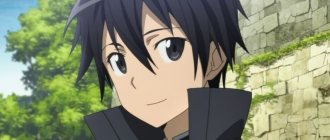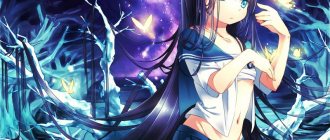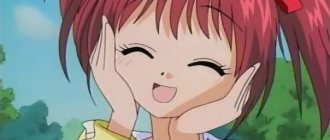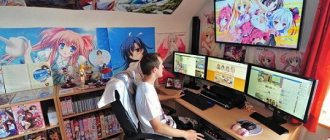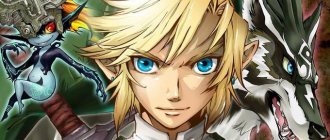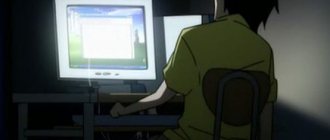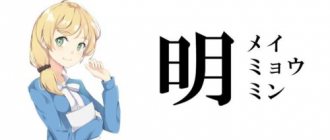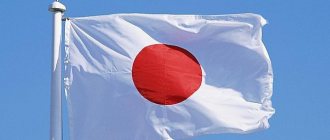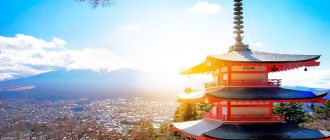Dictionary of anime terms.
First, it’s worth talking a little about Russian anime slang.
Speaking about Russian anime jargon , it should be noted that the lion's share of all “anime words” came to us from Western anime communities and are either Russified English concepts (for example, “opening”, “haremnik”, “deforming”, “scanlating” ), or Japanese words (for example, “sugoiny”, “kawaii”, “yaoischik”, etc.) But it is worth remembering that often when words migrate from the Japanese source to overseas anime communities, the meaning of these words was greatly distorted, so that as a result, the term used in the anime environment is sometimes far in meaning from its Japanese counterpart.
Anime name abbreviations:
AMG - Ah! My Goddess! (Ah! My goddess!)
BGC - Bubblegum Crisis (Crisis every day)
GITS - Ghost in the Shell
Eva - Shinseiki Evangelion (New Generation Evangelion)
FF - Final Fantasy
FY – Fushigi Yuugi (Amazing game
HNT – Hi-no Tori (Firebird )
MI - Maison Ikkoku (Ikkoku Apartment House)
KOR - Kimagure Orange Road
MH - Mononoke Hime (Princess of Monsters)
N2 - Bannou Bunka Nekomusume Nuku-Nuku (Multifunctional Civilized Cat Girl Nuku-Nuku)
NGE - Neon Genesis Evangelion = Eva
R1/2 - Ranma 1/2 (Ranma 1/2)
SFII - Street Fighter II
SM - Bishoujo Senshi Sailor Moon (Beautiful warrior Sailor Moon)
UY - Urusei Yatsura (Those obnoxious aliens)
Animessianicism is the promotion of anime to the masses.
Apocalyptic - associated with the story of the End of the World. Anno Hideaki is one of the largest anime directors
Apocalyptic is a type of anime that tells about the coming of the End of the World.
Action is a genre of shonen anime, the action of which is associated with combat confrontation.
Martial arts is a genre of anime, the plot of which is related to the confrontation between masters of various martial arts.
Baka gaijin is usually American.
Baka (baka) - idiot, cretin, fool, blockhead, dunce, etc. (Naughty...))) -_^
Bishounen - This is usually the name given to graceful, effeminate young men, those whom people ignorant of anime mistake for girls. Bishounen are often associated with yaoi...
The main characteristics of bishounens:
Young age. They are never over 18 years old (and more often - 14-16)
Striking resemblance to girls. They are essentially “girl substitutes” in relationships
Bishounens come in two types: kind, generous, talented, silent, shy - this is the first type, and dynamic, obsessed with all kinds of battles, cheerful, often speaking in a raised voice - this is the second type
Bishounen are often associated with yaoi. But this is not always the case. Bishounens of the second type often have no actual connection with him at all, although the sophisticated fantasies of fans can confuse them (take, for example, Van from “Vision of Escaflowne”, a good half of the guys from “Gundam”, Omi from “White Cross”). Representatives of the first type are passive, but this does not guarantee their participation in yaoi. The most common two types of couples are a strong boy - a weak boy and a strong girl - a weak boy (for example, Kamui and Fuuma from "X" and Yuri and Mickey from "Utena")
All bishounens wear short pants (so everyone can enjoy the sight of their knees). Although not all bishounen wear them, all who wear them are bishounen.
Big eyes. In Japan, big eyes are a symbol of youthful beauty. It is believed that large beautiful eyes are the main feature of the Japanese style in animation and comics.
Gaijin is a foreigner (from a Japanese point of view).
Gallery of unsorted GIFs of anime-manga pictures!
The main people in Anime
Tezuko Osamu is one of the founders of modern anime (manga god).
Ishinomori Shotaro is one of the creators and classics of the modern manga industry
Kanno Yoko is the most famous female composer in Japan. She became famous for the soundtrack to the cartoon "Makros Plus".
Blood type - A common theory in Japan is that blood type, like an astrological sign, influences character type. Only the group number matters, the Rh factor is not important. In Japanese pop culture, blood type is believed to correlate with personality. This belief spread in the early eighties. Biographical descriptions of manga artists or their characters often list blood type along with information such as age or place of birth. Here is a very rough summary of blood types:
A (2) nervous, self-absorbed, honest, loyal
B (3) open-minded, optimistic, adventurous
AB (4) proud, diplomatic, insightful
O (1) “workaholic”, insecure, emotional
Josei is a young woman.
Doubutsu - “fluffy” anime about humanoid and intelligent “furry” creatures.
Doujinshi is a manga created on a non-profit, non-professional basis. Often based on famous commercial manga.
Jo anime is an anime aimed at young women.
Detective is a type of anime whose action is related to the investigation of crimes.
Dobutsu is a “fluffy” anime about humanoid “furry” creatures.
Drama is a rather rare genre of dramatic and tragic storytelling for anime. The main symptom is the absence of a pronounced “happy ending”.
Doraemon is the name of the most popular cat in Japan. This manga hero first appeared in 1974. Since then, comics and cartoons about Doraemon have become almost classic manga and anime for children. For almost 26 years now, the super cat has been helping his friend Nobi Nobita, a lazy fourth grader, in his life. It is worth noting that
Doraemon is not a real cat. He is a robot sent from the future. And not the smartest robot. But he is a very cheerful and amusing creature. Doraemon also has a four-dimensional pocket on his stomach. From there he periodically pulls out various things and gadgets. Interestingly, the robot cat used to have ears. But mice chewed them off for him in a fight. Since then, the super cat does not like and is afraid of gray rodents.
Idols is an anime that revolves around pop stars and the music business.
History is a type of anime, the action of which is connected with certain real historical events.
Kawaii - cute, cute.
Space opera is a type of sci-fi anime that focuses on wars taking place with the active use of spaceships.
Cyberpunk is a genre of anime that tells about the world of the future, the life of which is completely determined by computer technology. At the same time, pictures of the future seem gloomy and dystopian.
Kami are spirits in Japanese mythology. There can be kami of nature, dead ancestors also become kami, gods in Japanese are also called kami. The worship of various kami is the basis of Shintoism, the main religious teaching of Japan.
Kodomo anime is an anime aimed at children.
A short film is an anime intended to be shown in a movie theater. It's shorter than 30 minutes, so it's always shown together with other similar films.
Manga and Anime. Otaku
Anime genres
A fairy tale is a genre of kodomo anime, a film adaptation of classic fairy tales.
Sentai literally means “group/team,” a genre of anime that follows the adventures of a small, standing team of characters fighting against someone or something.
Spokon is a genre of anime that tells the story of young athletes who achieve success by cultivating the will to win. Combining the words “sport” and “konjo” (“willpower”).
Social film or series - anime that raises pressing issues of modern society
Comedy is a type of anime, the main thing for which is humor: parodies, sitcoms, verbal and stunt jokes.
Cyberpunk is a genre of shonen anime/manga that tells about the world of the future, the life of which is completely determined by computer technology. Ideologically close to the “dystopian” genre. Kodomo is a child.
Manga are Japanese comics. This is a whole trend in comics, invented once in Japan. Nowadays manga is drawn not only in its homeland, but also far beyond its borders, for example in Russia... It is interesting that real manga is most often in black and white. These are “uncolored” thick magazines with colored covers (tankobon). Japanese comics are loved not only by children and teenagers, but also by adults. Therefore, there are many styles and types in manga and anime. Genres can also be very diverse: from fairy-tale fiction to detective stories.
Girls in manga and anime, how they changed from the 60s to the 2000s!
Mangaka is the creator of manga.
Maho-shojo - “magical girls (girls),” a genre of shojo anime/manga that tells about the adventures of girls and girls endowed with unusual magical powers.
Mecha - any complex mechanisms in anime/manga (robots, vehicles, etc.).
Mecha Sentai is the same as Sentai, with a team of characters piloting one or more “giant robot” mecha.
Mechs are complex mechanisms, usually self-propelled, that do not have real prototypes (i.e., invented specifically for this project). This term usually refers to “giant robots,” huge human-controlled fighting machines. The fur genre is characterized by the active use of fur.
Mecha Sentai is the same as sentai, but a team of characters pilots one or more mecha.
Maho-shojo - “magical girls”, a genre of shoujo anime that tells about the adventures of girls endowed with magical powers. Concentrates on the problems of growing up as a woman.
Mysticism is a genre of anime, the action of which is associated with the interaction of people and various mysterious forces. The latter do not lend themselves to an unambiguous scientific description, which is how they differ from, say, magic in fantasy. Relationships with them are usually associated with various moral problems.
Soap opera is a genre of romantic shoujo anime that focuses on telling complex and intricate love stories.
Science fiction (SF) is an anime whose action is related to the existence and use of technology that did not exist at the time of the creation of this anime (interstellar spaceships, blasters, etc.) Typically, SF anime sets out the possible history of the future of humanity, often its plots are related with contacts with aliens.
Neka is a cat girl. On their own, neks, or simply cat girls, are affectionate, gentle and terribly insidious creatures, never parting with their fluffy ears, gloves and tail. And even if I wanted to, it would not have been possible to separate =^_^=. By the way, there are also those who attach all sorts of bows, dresses, ears, rattles, gloves and boots to themselves, and then proudly declare a solemn “Nya!” to everyone present. A real neka will never, in one of her nine lives, refuse a plate of warm milk or fresh fish accidentally forgotten by someone. Any cat girl who respects herself and others like her says only a short “nya” in different intonations, being in a cultural society. There are no nude hentai girls. And in general, who wouldn’t be touched by the sight of a tiny, peacefully “snooping” fluffy ball asleep in a milk bowl.
SF - science fiction.
Otaku is a type of anime that contains references to the activities of anime fans.
Otaka - Activities of otakus to convince non-otakus of the merits of anime/manga.
Otakovat - engage in otakovat.
An otaku is more than just a fan of anime/manga. (a book may not be enough to describe this phenomenon
Full-length film, full-length (movie) - anime intended for showing in a cinema, usually longer than 50 minutes.
A full-length film is an anime intended to be shown in a movie theater. Rarely shorter than 50 minutes, the usual length is from 60 to 90 minutes
Steampunk is a genre of anime that tells about alternatives to our world, at a level of technical development corresponding to Europe at the end of the 19th century. This period is characterized by the beginning of a revolution in technical means of transportation - the appearance of airships, airplanes, steam locomotives, and steamships. Technology, however, is still perceived by ordinary people not as something familiar and banal, but as something miraculous and, often, demonic. Steampunk arose as an alternative to cyberpunk. While cyberpunk is usually based on a futuristic aesthetic, steampunk is usually based on a retro aesthetic.
Travel between worlds is a type of anime in which the main character or characters move between parallel worlds, usually between the world of modern Japan and a fantasy world.
Post-apocalyptic is a type of anime that tells about life after a global catastrophe - the End of the World.
Parapsychology is a genre of anime, the action of which is associated with parapsychic powers (telepathy, telekinesis, hypnosis).
Everyday is an anime that describes the everyday life of ordinary Japanese (usually middle class) with all its joys and troubles.
Psychological thriller is a genre of anime that tells about the “adventures of the human soul.” Finding themselves in unusual situations, the heroes of such anime experience complex and unpredictable psychological changes.
Police action is a genre of shonen anime that describes the actions of the police to identify criminals and apprehend them.
Romance is an anime that tells about love conflicts.
Sadomasochism (S&M) - A type of hentai that contains images of torture and suffering inflicted as a perverted expression of love.
Sailor Moon - The Sailor Moon series was filmed at the Japanese studio Tou Animation based on the plot of the manga created by artist Naoko Takeuchi. It premiered on Japanese television in 1992.
Sailor fuku - “sailor suit”, a common Japanese female school uniform.
Shojo - girl/girl (for Japan - from 12 to 18 years old).
Shonen - boy/young man (for Japan - from 12 to 18 years old).
A script is a sequential recording of the dialogues of a film, used in its dubbing or translation. A more precise technical Russian term is “installation sheets”.
Spokon is a genre of anime/manga that tells the story of young athletes who achieve success by cultivating the will to win. A combination of the words sport and konjou (willpower).
Shounen anime is anime intended for older boys and young men (from 12 to 16-18 years old).
Shoujo anime is anime intended for older girls and young women (from 12 to 16-18 years old).
Seinen anime is an anime aimed at young men.
Seinen is a young man.
Voice actor is an anime voice actor/actress.
Senpai means “senior comrade.”
Sensei is a teacher, mentor, guru.
Sentai is literally “group/team,” a genre of anime/manga that follows the adventures of a small, standing team of characters fighting against someone or something.
Tankobon is a book reprint volume of a magazine manga.
Tankobon edition is a re-release of magazine manga in book format.
TV series (TV-series) is an anime intended for showing on TV.
TV series is a serial anime intended to be shown on television.
A TV movie is a non-serial anime intended to be shown on television.
Tokusatsu - special effects. This is usually the name given to feature (non-animated) Japanese films and TV series (usually fantastic) with a lot of special effects. The classic and well-known tokusatsu is “Godzilla”. Many tokusatsu in recent decades are based on manga/anime, sometimes starring actors known for their voice work in anime. This word is used to refer to special effects in anime.
Phallic cult - (from the Greek fallos - penis) Phallic symbolism has been associated with fertility cults since ancient times (for example, in various agricultural rituals).
Fantasy is an anime that tells about worlds ruled not by technology (as in SF), but by “sword and sorcery.” Fantasy often features not only people, but also a variety of mythological creatures - elves, gnomes, dragons, werewolves, cat people, as well as gods and demons.
Fanart is any artistic creation by anime fans.
Fan fiction is any literary work by anime fans (otaku).
Fan service - non-genre-defining, plot-unjustified nudity/half-nudity (shower scenes, transformations, etc.). For example, in the TV series "Space Fortress Macross" there is Lynn Minmay fan service. This also includes openly parody or humorous scenes, like the famous striptease scene in the OAV series “Tank Police”.
Henshin - transformation/transformation of a character/mech (transforming robot). Often associated with "dressing up" a character.
Hentai is erotic or *****graphic anime.
Hentai (hentai) - erotic/***** anime/manga. Literally translated as “perverted”, abnormal. (From a formal point of view, it should be written and pronounced “hentai”, but the term “hentai” has already been established in this way). Common general term for erotica and *****graphy in anime and manga.
Censorship - According to Japanese law, depictions of genitals are strictly limited and generally prohibited. Therefore, the animators or artists themselves paint over the corresponding places, or sketch them with white or black circles. When these productions are exported overseas, the "censorship" is sometimes removed, so the American dubbed versions are sometimes fuller than the Japanese originals. True, internal American censorship is often involved... The first hentai anime is considered to be the OAV series Lolita (1984), and the first influential anime that defined the hentai canon is the OAV series Cream Lemon ] (1984-1986).
Chibi - small.
School soap opera is a type of soap opera that depicts the love stories of schoolchildren.
School detective is a genre of shonen anime in which investigative actions are carried out by schoolchildren.
Schoolgirls is a special term adopted in the description of *****graphy. In these types of films, adult women/girls dress in school uniforms and act like schoolgirls, demonstrating supposed "inexperience" and "innocence" in sexual relationships. In no case should it be confused with child *****graphy (actual filming of small children) and teens (filming of young girls who do not disguise their real age)!!!
Tentacles - A type of hentai, the depiction of male genital organs in the form of huge tentacles as a distinctive feature of many monsters. Typically, tentacles are a sign of a werewolf demon. In traditional Japanese graphics, the association of tentacles and male genital organs has been traced since time immemorial. The anime that defined the Tentacles canon is the OAV series Urotsukidoji (1987-1989).
Erotica - plot-based nudity (love scenes of all kinds and types), but without an overt display of the sexual act itself. The plot of the anime is related to love themes.
Yaoi is a genre of shoujo anime that talks about male homosexual relationships.
Yuri is a genre of shoujo anime that talks about female homosexual relationships.
Yakuza is the Japanese mafia. _________________
AMD (Anime Must Die) is an online organization dedicated to fighting anime and anime fans. Most of its members are characterized by a love of Walt Disney Co. films. and to the use of swearing. There is also a certain punk bias, ignorance both in the field of anime and in the field of their favorite films, and a love of free Internet access. It is important to distinguish AMD members from normal Disney fans, who are usually quite friendly and respectful of our activities, which feelings on our part only cause mutual sympathy. AMD has the right to show itself “in all its glory” the way they want, but not where obvious hostility and the use of obscene language are prohibited by the rules, say, on the vast majority of “freebie” sites. As for the subject of the showdown itself, the “Disney vs Anime” debate is considered a matter of personal taste, and not scientific debate. The goal of the otaku is not for only Japanese animation to be shown in Russia. Even in Japan this is not the case. The goal of the otaku is for Japanese animation to be not only known in Russia, but also as familiar as Disney is now in Russia. What place Disney will take in Russian culture is another matter.
ADR (AY-dee-ar) - Abbreviation for automatic. Automated Dialogue Recording, during which the Russian or any other version of the script is changed enough to match the movements of the characters' mouths on the screen. Translation from another language that is inaccurate or too inconsistent with mouth movements can make it very difficult to overlay a script on a video. Example: ADR for Viz Video episodes is usually done at their studio in Canada. See also: Dub.
Anou (ah-NOH, Ano) - translated as “well” or “uh”. The more cultural form of "anone" translates to "excuse me." Example: Anou... Could you look here please.
Bakemono (BAH-keh-moh-noh) - translates to "monster" or "mutant". Some demons and other creatures may be called this by humans, but other forms/words such as "oni" and "youma" may also be used as a creature type. Example: Our missiles cannot hit him. This is bakemono...
BGM (BEE-gee-em) - Background music, instrumental soundtracks found in many anime. In Japan, the practice is to release BGM CDs as CDs with songs from the most popular anime. Example: I've heard BGM for the Rurouni Kenshin series. This is a complete blast!!!
Dub (DUHB) - A form (from the word - duplicate) of anime translated by non-Japanese in the cultural traditions of their language, mainly in order to understand the dialogue. Often, many translations contain stretching of the words of their language, because... when the actor (character) speaks, they blend perfectly with the movement of the character's lips. As a result, the actual translation may be lost, replaced, or slightly distorted by the selection of more suitable synonyms. An example of this is the word stretching system. Those anime fans who know Japanese may not like the versions of the anime translated into English or Russian. Those who don’t know, of course, prefer the English or Russian versions. Example: Golden Boy is fine, but they made the worst dub for him. Other forms: dubbed (adj., v.), dubbing (n., v.) See also: fandub, ADR.
J-Rock - Japanese rock music.
OAV/OVA is an anime made specifically for release on video and not intended for showing on television or in cinemas (“Original Animation Video”). OAV/OVA is an anime created specifically for release on video (Original Animation Video). It can be both serial and single. Currently, the standard OAV length is 23-25 minutes, but in the 1980s and early 1990s there were both hour-long and longer OAVs.
OST (Original Sound Track) - original soundtrack (sound track). AMD (Anime Must Die) is an online anti-anime and anti-anime fan organization. Most of its members are characterized by a love of Walt Disney Co. films. and to the use of swearing. There is also a certain punk bias, ignorance both in the field of anime and in the field of their favorite films, and a love of free Internet access. It is important to distinguish AMD members from normal Disney fans, who are usually quite friendly and respectful of our activities, which feelings on our part only cause mutual sympathy. AMD has the right to show itself “in all its glory” the way they want, but not where obvious hostility and the use of obscene language are prohibited by the rules, say, on the vast majority of “freebie” sites. As for the subject of the showdown itself, the “Disney vs Anime” debate is considered a matter of personal taste, and not scientific debate. The goal of the otaku is not to have only Japanese animation shown in Russia. Even in Japan this is not the case. The goal of the otaku is for Japanese animation to be not only known in Russia, but also as familiar as Disney is now in Russia. What place Disney will take in Russian culture is another matter.
Ani-Mayhem (AH-nee-may-hehm or AN-nee-may-hehm) - The name of a trading card game using anime characters from many series, including but not limited to Ranma 1/2, Tenchi Muyo, Bubblegum Crisis and Dragonball Z. Example: - Today I played Ani-Mayhem with my friend.
Arigato (ah-REE-gah-toh, arigato) - translated as “thank you.” A more cultural form using the addition “gozaimasu” is translated as “thank you very much.” Example: I received the papers you left me. Arigato gozaimasu! Another form: arigatou. AMD (Anime Must Die) is an online organization dedicated to fighting anime and anime fans. Most of its members are characterized by a love of Walt Disney Co. films. and to the use of swearing. There is also a certain punk bias, ignorance both in the field of anime and in the field of their favorite films, and a love of free Internet access. It is important to distinguish AMD members from normal Disney fans, who are usually quite friendly and respectful of our activities, which feelings on our part only cause mutual sympathy. AMD has the right to show itself “in all its glory” the way they want, but not where obvious hostility and the use of obscene language are prohibited by the rules, say, on the vast majority of “freebie” sites. As for the subject of the showdown itself, the “Disney vs Anime” debate is considered a matter of personal taste, and not scientific debate. The goal of the otaku is not to have only Japanese animation shown in Russia. Even in Japan this is not the case. The goal of the otaku is for Japanese animation to be not only known in Russia, but also as familiar as Disney is now in Russia. What place Disney will take in Russian culture is another matter.
Sensei is the respectful equivalent of the word “teacher”, “educator”, “master”, this is the name given to senior, respected professionals of any kind. Nowadays, many manga artists are called sensei.
Top 10 (2017). Anime characters with huge "buffs" that changed the lives of otakus forever. 16+
Views: 3,625
Share link:
- Tweet
- Share posts on Tumblr
- Telegram
- More
- by email
- Seal
Liked this:
Like
